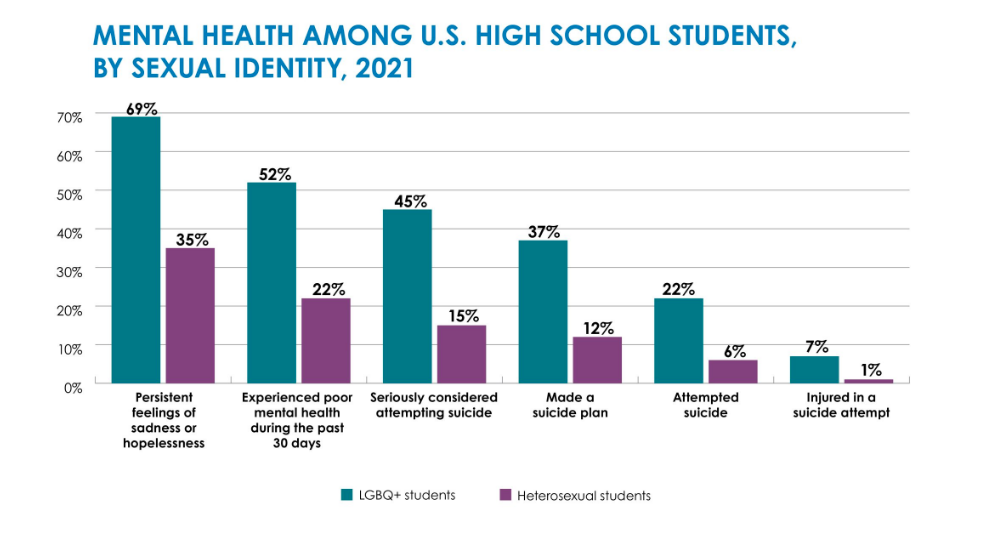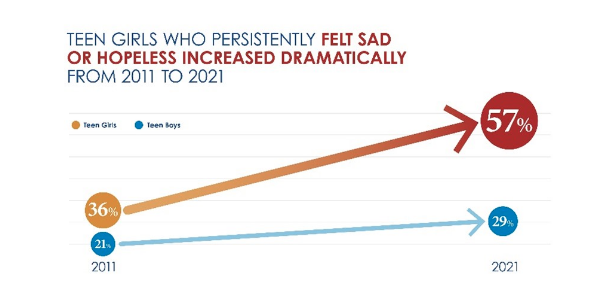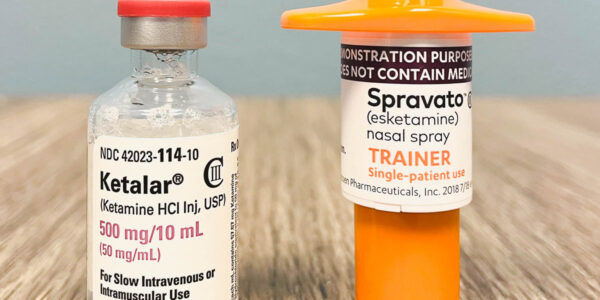LISTEN TO THIS ARTICLE:
A new report published by the Centers for Disease Control and Prevention (CDC) raises alarm about the mental health of teenage girls and LGBTQ+ youth in the United States. Teen girls and LGBTQ+ youth are experiencing record levels of sexual assault, violence, sadness, anxiety, and suicide risk. The information comes from the Youth Risk Behavior Survey, which provides the most recent data as well as 10-year trends of behavioral health among US high school students.
According to the survey, approximately 3 in 5 girls stated they felt constantly sad and hopeless in 2021. The percentage has increased from 36% in 2011 to 57% in 2021. Although all teens reported a rise in mental health struggles, violence, and suicide risk, girls were twice as likely to express these issues than boys. In addition to increased sadness, nearly 30% of teen girls seriously considered attempting suicide while 18% experienced sexual violence in the past year. These numbers are up 60% and 20% respectively. Moreover, 14% of teen girls had been forced to have sex. Sadly, this statistic has risen by a third since 2019.
LGBTQ+ youth mental health
The new report highlights the dire situation among teens who identify with the LGBTQ+ community. In 2021, more than half (52%) of LGBTQ+ students surveyed stated they experienced poor mental health within the past 30 days. Over 2 in 3 had persistent feelings of sadness or hopelessness. More than 10% of LGBTQ+ students skipped school because of fear for their safety. Almost 1 in 4 experienced sexual violence and were bullied at school. Even more alarmingly, 1 in 5 (22%) attempted suicide in 2021.

Schools play an important role
Almost all youth in the United States spend a majority of their time at school. School connectedness is a critical way to help student health and development. This is achieved when students feel as though adults and peers care for and support them, which leads to a sense of belonging. As a result, schools have the potential to implement resources for teens to help decrease hopelessness, violence, and suicide risk. School-based activities and resources can make a big difference. This is especially true for girls and LGBTQ+ youth who have vulnerable mental health.
Encourage participation in sports and community clubs
Time in nature and exercising outside help decrease depression.
Teenage participation in sports and community clubs in schools is associated with positive mental health benefits. High school athletes often report decreased levels of anxiety and depression as well as a better quality of life. These benefits increase for teenagers who participate in team sports, which help adolescents feel like a part of a community. Moreover, schools with clubs that help teens spend time in green spaces, such as outdoor leadership programs, are especially valuable. Spending time in nature and exercising outside help decrease depression and increase social well-being. Sports and clubs also provide adult mentorship for students outside of the academic classroom. Parents and school staff should encourage teens to participate in sports and community clubs to help decrease sadness and increase feelings of belonging.
Mental health first aid training for schools staff
School administrators, teachers, coaches, and other staff must be equipped with the right skills to help students. Similar to Basic Life Support and CPR training, schools should implement youth mental health first aid training for all adults who work with children. Mental Health First Aid (MHFA) is a national, evidence-based program that helps teach the skills required to identify and respond to signs of mental illness. It is administered by the National Council for Mental Wellbeing. The program has over 15,000 instructors who have trained more than 2.6 million people across the United States.
Increase certified mental health professionals in schools
United States schools are in critical need of more certified mental health professionals. During the 2021 – 2022 school year, the American School Counselor Association reported that the average school counselor to student ratio was 408-to-1. The school psychologist to student ratio was even lower. In the same year, the National Association of School Psychologists reported that the ratio was 1,127 students to 1 psychologist.
One way to address this issue is to build school-community partnerships. School administrators and healthcare staff should work directly with local primary care and mental health clinics to increase access to resources for students in need.
Implement inclusive practices
In a safe space, students have the opportunity to share stories and generate conversation about their daily lived experiences.
Schools can address the ongoing mental health crisis for teenagers by implementing practices that are inclusive of girls and LGBTQ+ youth. The development of gender and sexuality alliances are positive spaces for students from marginalized groups to develop allies with their peers. Moreover, the creation of safe spaces, such as affinity groups, can be beneficial. Affinity groups are made of people who share a common identity, such as being female or LGBTQ+. In this space, students have the opportunity to share stories and generate conversation about their daily lived experiences with the support of a staff member who ideally shares the same identity characteristic or has been professionally trained on the subject.
Finally, schools should have policies that support inclusivity. Outlining anti-harassment policies with clear consequences is critical. The increase in sadness, violence, and suicide risk among US teens, especially girls and LGBTQ+ students, is a very concerning trend. The healthcare and education systems must work together with urgency to support the mental and physical health of teenagers.


 Learn
Learn Read Stories
Read Stories Get News
Get News Find Help
Find Help


 Share
Share
 Share
Share
 Share
Share
 Share
Share



